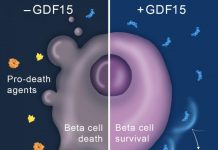MARCH 2003 - Jerusalem � Research conducted by scientists at the Hebrew University of Jerusalem and the U.S. Department of Energy's Brookhaven National Laboratory has paved the way for development of highly efficient sensors for measuring blood glucose in diabetic patients. The research, based on the use of nanotechnology, is described in the current issue of Science magazine.
The Hebrew University research team is headed by Prof. Itamar Willner of the Hebrew University Institute of Chemistry.
Particles the size of a nanometer (that is, one- billionth of a meter), which are the building blocks of the science of nanotechnology, have comparable dimensions to animal or plant proteins, thus enabling the integration of these components into hybrid systems exhibiting novel properties.
In the Hebrew University-Brookhaven research, the scientists have succeeded in implanting a gold nanoparticle with a diameter of 1.2 nanometers into the enzyme glucose oxidase.
Prof. Willner explained that the enzyme glucose oxidase, like most other enzymes, acts as an insulator when binding to a conductive surface such as an electrode. However, when the gold nanoparticle is implanted into the enzyme, the gold acts as an electrical "plug," facilitating the flow of electrons to the attached electrode and the oxidation of the glucose by the enzyme. The magnitude of the current reveals the extent of glucose in the system.
Continue Reading Below ↓↓↓
Experimental results have shown that this "nanoplug" technology yields more sensitive and specific measuring of glucose in the blood then has been possible with existing techniques.
The researchers believe that enzyme electrodes of this type are likely to serve in the future as tiny devices not only to sense glucose levels for diabetic patients, but also as implanted biofuel cells that would enable production of electrical energy from blood sugar to operate heart pacemakers, insulin pumps or prosthetic components.
Source: Hebrew University of Jerusalem









